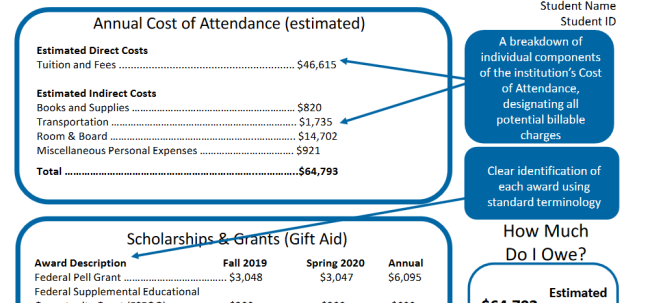You have /5 articles left.
Sign up for a free account or log in.

Sample aid notification form
National Association of Student Financial Aid Administrators
For years, many consumer advocates and education finance experts have criticized the way some colleges tell admitted applicants about the financial aid they will receive if they enroll.
Studies have found inconsistencies in how colleges describe the same forms of aid and have criticized suggesting that loans are the same as grants. Others have criticized colleges for not distinguishing among various forms of loans. Given that many students and their families may not understand the significance of borrowing through a federal versus private loan program, for example, critics say that less-than-clear aid letters make it difficult for students and families to make informed decisions.
With students who have multiple admission offers for the fall deciding where to enroll, the U.S. Education Department's Office of Federal Student Aid last week issued guidance to colleges on their aid explanations. The recommendations:
- "Avoid calling your financial aid offer an 'award' and avoid calling it a 'letter.' Loans are not awards. Work-study is not an award, it is the potential for employment that offers earnings to students. Using a term like 'financial aid offer' or 'college financing' is clearer. Given that many institutions deliver these offers via electronic communication, calling them 'letter' can also be confusing."
- "Avoid issuing a financial aid offer that does not include cost of attendance."
- "Avoid listing the cost of attendance without breaking it down into clear components. For students and families to be able to plan how to cover costs, the provided cost of attendance needs to be transparent about what is and is not included. While basic needs like food and shelter are critical, other key costs such as books, supplies, medical insurance and transportation also need to be anticipated as students and families determine if a school is a financial fit for them."
- "Avoid listing grant and/or scholarship aid, loans and work-study together. Listing grant and/or scholarship aid, loans and work-study together can lead students and families to confuse the terms and their specific requirements. Listing them separately makes it clear what is a loan (needs to be paid back), what is a grant or scholarship (does not need to be repaid), and what constitutes as work-study (must be earned by securing a job and working to receive it)."
- "Avoid listing student loans without clarifying the source (federal, state, institutional or private)."
- "Avoid listing Parent PLUS loans with student loans. Parent PLUS loans are different than student loans and involve higher risk."
- "Avoid issuing a financial aid offer without net cost calculated. Net cost is the difference between the total cost of attendance and all grant/scholarship aid received. Not including net cost is confusing to students and families and makes comparing financial aid offers very difficult, if not impossible."
Megan Coval, vice president for policy and federal relations at the National Association of Student Financial Aid Administrators, said the guidance from the Education Department was generally consistent with her organization's views. NASFAA has a code of conduct that covers many of the same issues.
The organization has endorsed efforts to promote greater clarity among aid offers. However, Coval noted that the organization has also opposed what it terms "rigid standardization" through legislation that would mandate a single aid notification method. Coval said that institutions have different missions, different student bodies and different aid resources, making it unrealistic to require that every aid notification look exactly alike.
At the same time, Coval said that the association takes seriously the need for colleges to be transparent with aid offers. She said the association receives "a handful" of complaints a year about colleges that are not providing information to students compliant with the association code. In these cases, she said, the association investigates and works with colleges to improve the way they share information about aid with admitted applicants. In every case, she said, the colleges have made the changes requested.
"I don't think schools are coming from a place where they are trying to mislead or be deceptive," she said.

![First text message: "Yes?" Second message: "This is embarrassing to say, but law school isn't fair for us men, the women are always outperforming us at [sic]. It's obvious women are taking over the legal profession nowadays." Third text: "Who is this?"](/sites/default/files/styles/image_192_x_128/public/2024-09/Text_messages_law_2.jpg?itok=0QWP419B)






